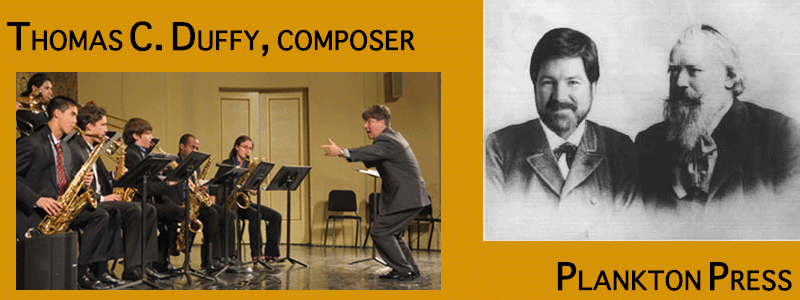Michigan's Motors
I. Cold Starts
II. Chasin' the Train
III. Cruisin'
IV. Auto Parts
(1996) 6:10
(Wind Band pc2,2,Eb 3 bc.,2atb sax/4,4,3,euph,tuba,timp.+4)
Commissioned by the Michigan School Band & Orchestra Association District No. 8
Level: High School/ College/ Professional
Michael Kaufman (Grand Ledge High School, Michigan) and I discussed the nature of this commission several times. "What is about your district that is unique or worthy of `programming' in a musical composition?" The attributes of the Michigan District #8 schools were too varied to suggest any theme of common interest so I tried to generalize the quest to include the entire state of Michigan.
Thus, here is Michigan's Motors, a title that is a tribute to the motor industry that flourishes today in Michigan, and a subtle clue as to the compositional techniques that serve as the foundation for this piece (motor rhythms).
I. Cold Starts - this onomatopoetic section is the musical equivalent of an engine being started for the first time on a cold day. Hear the cranking sounds of the starter, the wheeze of the carburetor, and the "almosts" of the engine, as, three times, the engine catches, fires, and chokes out. Finally, the engine catches for real, and gradually warms up to a reasonable idle.
II. Chasing the Train - what to do with the running car? Why, let's raise the train, just like in the older moviesthe car races the locomotive and zips across the tracks in the nick of time, just missing the train. Hear the two engines, running side by side, and the blare of the train's horn! The car does survive and, after the last train horn blast, motors off in arrogant disinterest and casual calmthis section is entitled:
III. Cruisin'- just what the title implies. The car is cruising around, perhaps playing punk rock on the radio, perhaps with the top down on a summer's day you decide. Obviously, the driver becomes enamored of the power of the automobile, as the drive and impact of the music builds up to an intense level. (Perhaps you yourself have snapped out of a trance induced by your car music, to find yourself unconsciously traveling well above the speed limit, hypnotized and commanded by the loud bass or the driving power of the music on the radio?)
IV. "Auto" Parts -The ancient compositional technique of soggeto cavato (carved subject) is used in this section to create musical melodies from the names of three car manufacturers: Ford, Dodge, and Cadillac. Each of the letters in the three car names have musical equivalents, drawn from solfeggio syllables or actual pitch names (including those pitches of H=B and S=Eb from German taxonomy, as follows:
Cadillac C as in the pitch C, A as in the pitch A, D as in the pitch D, I as in Mi = E, L as in La=A, L as in Sol=G, and C as in the pitch C.
Ford F=as in the pitch F, O as in sol = G, R as in Re = D, D as in Do=C
Dodge D as in the pitch D, O as in Do=C, D as in the pitch D, G as in the pitch G, and E as in the Pitch E.
MM. 85-98- Upper woodwinds have an ostinato figure made up of the pitches spelling Cadillac.
Mm. 89-98, the trumpets 1 and 3 and the Horns 1 and 3 present an ostinato figure drawn from the pitches spelling Dodge.
Mm. 93-98, trumpets 2 and 4 and horns 2 and 4 have an ostinato figure made up of the pitches spelling Ford. Thus, auto parts.
V. Horse Power - At m. 99, the ostinato pitches change. Here the predominant concern is the "auto" part of automotion, that is to say, self-propulsion. The piccolo and first flutes have pitches that spell "Horse.
Horse H is B in German nomenclature. O is Do = C, R is Re = D, S is Eb in German nomenclature, E is the pitch E.
The oboes and second flutes have pitches that spell "Feet."
Feet F as in the pitch F, E as in the pitch E, and T as in Ti = B.
The ensemble contributes to the idea of manual power (as opposed to auto-motive power) by clapping the motor rhythms with their hands.
The piece ends with a return of the Cruising music, and the final sound is of the engine wheezing to a halt.

